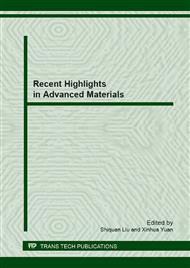p.123
p.130
p.137
p.142
p.147
p.151
p.156
p.160
p.166
A Self-Repair Mode for Capillary Reinforced Polymer Composite
Abstract:
The paper describes a novel capillary reinforced plastic which can self-repair the impact damage in polymer composites through employing a bio-mimetic approach. A epoxy resin E-51 and harder WSR706# was used as the healing agent, the two components being filled in to different directions (0°and 90° fibers). Impact test and tensile test were used as a measure of the self-healing effectiveness. The results of flexural testing have shown that strength lost after impact damage can be restored by the self-healing effect with healing agent stored in capillaries, and a significant fraction (about 79%) of lost mechanical strength is restored by this effect. At the same time, the paper also studied the morphology of fracture surface of no embedded and capillaries embedded sample. And micrographs of crack morphology which has been healed have been observed.
Info:
Periodical:
Pages:
147-150
Citation:
Online since:
September 2013
Authors:
Keywords:
Price:
Сopyright:
© 2014 Trans Tech Publications Ltd. All Rights Reserved
Share:
Citation:


